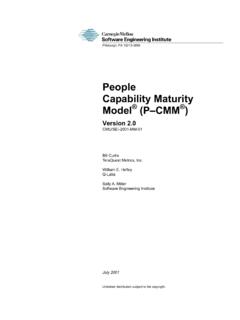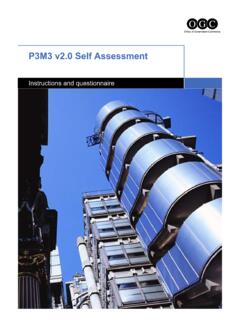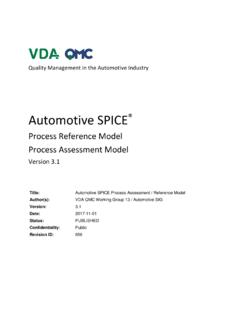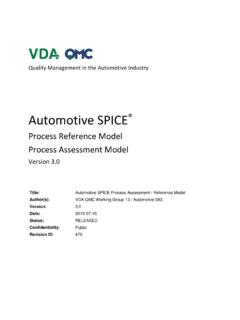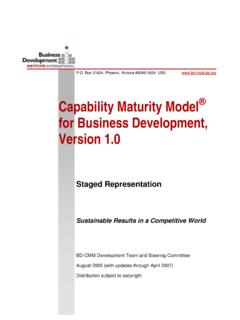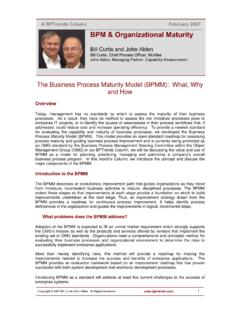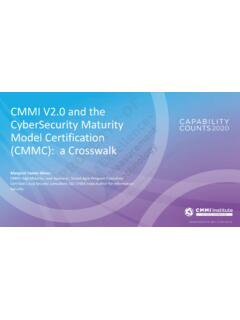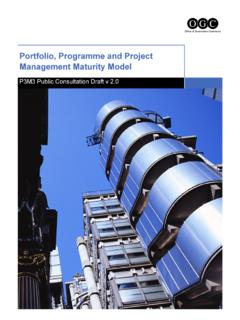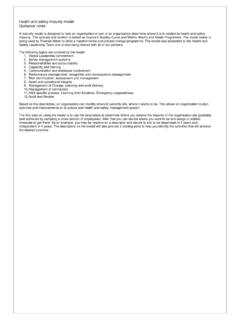Transcription of Organizational Project Management Maturity Model
1 Project Management Standards Program standards which are widely recognized and consistently applied Organizational ProjectManagement Maturity ModelEmerging StandardsJohn Schlichter 2001 Project Management Institute, Inc. All rights Describe strategic context of opm3 Describe Elements of the Model and capabilities Explain Key Processes and process improvement steps Explain Integration - preliminary design Describe Prototyping Describe Beta TestingStrategic ContextOPM3 is a strategic weapon! Organizational Project Management not simply single- Project Management , Guide strategic domain encompassing more thanthe multiple Project delivery systems ofprogram Management spans both activities that align projects tostrategic priorities and infrastructure thatenables the Project environmentPROJECT APROJECT BPROJECT CPROJECT DPROJECT EPROJECT FPROJECT LPROJECT KPROJECT JPROJECT IPROJECT HPROJECT GCOMPANYOBJECTIVESMISSION.
2 VISIONINTERFACINGPRODUCTTARGETSMONITORMA RKETOPPORTUNITIESCREATEPRODUCTPORTFOLIOP ROCUREMENTTEAMMOBILISATIONLOGISTICSSOURC ERESOURCESMULTI-DISCIPLINEDTEAMSOPERATIO NALGOALSPROJECT-SPECIFIC PRINCIPLESGENERAL Project ALIGNMENTSTAKEHOLDERMANAGEMENTRISKANALYS ISORGANISATIONALOVERVIEWSTRATEGICPROJECT PLANNINGPRIORITISATIONENTERPRISEMANAGEME NTCOMPANYSTRATEGICOBJECTIVESP roject Delivery SystemsGENERAL Project ALIGNMENTSTAKEHOLDERMANAGEMENTRISKANALYS ISORGANISATIONALOVERVIEWSTRATEGICPROJECT PLANNINGPRIORITISATIONENTERPRISEMANAGEME NTCOMPANYSTRATEGICOBJECTIVESE nterprise ProjectManagementCOMPANYSTRATEGICOBJECTI VES Paul Dinsmore, 1999 & Human Systems Limited 1999,2000 STRATEGICPROJECTSPRODUCT &MARKET-RELATEDPROJECTSOPERATIONAL PROJECTSCAPITAL EXPANSION PROJECTSS trategic ContextStrategic ContextORGANIZATIONALPROJECTMANAGEMENTWo rk between organizations Networked Organizations Strategic Context We want to strengthen the link betweenorganizational strategy and execution so projectoutcomes equate to Organizational success.
3 Capabilities distinguish organizations that cantranslate organization strategy repeatedly andreliably into successful Project outcomes Organizational routines or processes can bemade capable processes driven by strategic priorities, includinglaunching and prioritizing projects, managing theportfolio of projects, and managing the organizationalenvironmentStrategic Context Whether an organization is fully projectized ornot, opm3 provides guidance regarding how to articulate Project success measure Project performance make the delivery of projects more predictable help projects work together instead of against eachother in a multi- Project environmentAbout This PresentationProcessesIntegratedModelDesi gnBest PracticesBest PracticesOPM Best Practices Using a version of DelphiRound 1 Open Guidance Team (GT)
4 Output = Possible 2 Semi-Closed GT + Standards Open DayOutput = Revised 3 Closed Pilot + Wide participationOutput = Analysis44321321++++44321321152412152412 Consolidated ResultsLed to Clusters 5 GroupsOPM3 Clusters Standardization &Integration ofProcesses Project SuccessCriteria Project Alignment &Prioritization Allocating Resourcesto Projects Performance Metrics Commitment to theProjectManagementProcess People &Competence Organizational Fit Teamwork ContinuousImprovementSingle Project Management is a fundamental buildingblock of opm3 , yet there is much Clusters Standardization &Integration ofProcesses Project SuccessCriteria Project Alignment &Prioritization Allocating Resourcesto Projects Performance Metrics Commitment to theProjectManagementProcess People &Competence Organizational Fit Teamwork ContinuousImprovementSingle Project Management is a fundamental buildingblock of opm3 .
5 Yet there is much Metrics Maturity improvement program Process compliance metrics Organizational effectivenesstracking Real-time Project performancefigures Standard presentation formats Measured training Best-in-class benchmarking Track record Customer satisfaction metrics Project ROI tracking Organizational performancetracking Integration of PM standards Performance system Formal performance assessment Full performance summarymetrics Planning baseline Project baseline tracking Lifecycle-linked metrics Product quality and customersatisfaction metrics Best-in-class gap analysis Repeat business due to projects Risk plans Risk Management Quantifiable specifications Quantifiable lessons Mathematical models for planning Consistency Accuracy Process analysis andimprovement metricsModeling Elements In most cases, you can not implementthese best practices overnight Must develop incremental capabilitiesthat aggregate to the best practices There are often dependencies amongthese incremental capabilitiesExample Best Practice Best-in-classBenchmarking Incremental capabilities leading up tothis best practice.
6 Per- Project basic metrics - Ability to work and measurein isolation Metrics gap-analysis - Ability to identify areas ofweakness of the existing measures Criteria development - Ability to define what needs to bemeasured and how the results would be used Benchmark application - Ability to assess theorganization based on best in class measures andhistorical information BIC metrics refinement - Ability to refine goals andmeasurements to reflect the Organizational environmentWhat-ifA3A2A1B3B2B1C3C2C1 ABCWhat-ifA3A2A1B3B2B1C3C2C1 ABCWhat-ifA3A2A1B3B2B1C3C2C1 ABCWhat-ifA3A2A1B3B2B1C3C2C1 ABCWhat-ifA3A2A1B3B2B1C3C2C1 ABCWhat-ifA3A2A1B3B2B1C3C2C1 ABCWhat-ifA3A2A1B3B2B1C3C2C1 ABCA bout This PresentationBest PracticesIntegratedModelDesignProcessesP rocessesOPM Processes We can talk about Organizational projectmanagement in terms of processes.
7 Process of Planning Strategies Process of Chartering Projects Process of Prioritizing Projects Process of Managing the Program andProject Portfolio Process of Individual Project Management Process of Managing the EnvironmentProcess Model We learned from the Quality Movementthat process performance improveswhen processes are standardized,measured, controlled, and & MaturitySource: Mark C. Paulk, Bill Curtis, Mary BethChrissis and Charles V. Weber. (1993) CapabilityMaturity Model for Software . SEI. Carnegie-Mellon University. Pittsburgh WattsHumphrey swork at (1)Initial(1)Repeatable(2)Repeatable(2)D efined(3)Defined(3)Managed(4)Managed(4)O ptimising(5)Optimising(5)Standard,consis tentprocessPredictableprocessContinually improvingprocessProcess Model The classic process Model consists offour components: Process Measurement Control Continuous Improvement These are the essentials of A process is a well-defined, conceptuallyrepeatable, systematic sequence of steps,methods, strategies, and/or approaches fortransforming inputs to outputs.
8 Operational definitions create uniform andcorrect behavior by the process operators,achieving standardization. Standardization means uniformimplementation of the work All processes can be measured, andmust be measured in order to controland improve them. Through measurement, we seek toincrease the value of processes and tosimplify them. Process measurement should focus onthe critical process characteristics orkey performance indicators. Measurement techniques must be In order for a process to be stable, theoutputs must be stable, how theprocess is operated must be stable, and(in nearly all cases) the inputs must bestable. Focus is on preventing process upsets. A system for maintaining processcontrol must include:1. An operational definition of stability2. A mechanism for detecting if stability islost, for detecting a process Improvement Continuous improvement means routine,systematic and sustained improvement ofprocesses and thus the products theyproduce.
9 Making improvements is fire-fighting, whileCI is systematic root-cause eliminationbased on analysis, integration with systemsthat standardize improvements, andwidespread deployment of involvement ImprovementProcessProcessProcessContinuo uslyImproveProcess BControlMeasureStandardizeSystematic and sustainedimprovement of processes andthus the products they order for a process to be stable, the outputs must be stable, how the process is operated must be stable, and (in nearly all cases) the inputs must be order for a process to be stable, the outputs must be stable, how the process is operated must be stable, and (in nearly all cases) the inputs must be ProcessesDesign andimplementOrganizationalStrategicPlann ingA1 Manage theEnvironmentA5 IdentifyProjects andDetermineCharteringConditionsA2 IdentifyProjects andDetermineCharteringConditionsA2(Re)pr ioritizeProjects and(Re)allocateResourcesA3(Re)prioritize Projects and(Re)allocateResourcesA3 ManageProgram andProjectPortfolioA4 ManageProgram andProjectPortfolioA4 About This PresentationBest PracticesProcessesIntegratedModelIntegra tedModelDesignOPM3 Preliminary Design The dependency logic of our clustersand the process improvement stagesrepresent our preliminary design.
10 We must fully integrate these to achievea detailed LogicA3A2A1B3B2B1C3C2C1 ABCP rocess ImprovementProcessProcessProcessProcessA ProcessProcessProcessProcessBProcessProc essProcessProcessCProcessProcessProcessP rocessDDependency LogicA3A2A1B3B2B1C3C2C1 ABCD esign Considerations The scope of capabilities represented byOPM3 is a large body of knowledge. The Model must allow the user to makeintelligent trade-off decisions easilyregarding the organization s path toimprovement. Organizations may beinterested in improving onedomain of organizationalproject Management butnot all Considerations To navigate the Model , you must knowwhere you are today, and you must knowthe routes available to get you where youwant to be. Assess your initial condition Identify trade-off s, or what-if scenarios Enable choices Provide recommendations based on yourchoicesOPM3 Designorganizational projectmanagement capabilities andtheir corresponding outcomessequence fordevelopingcapabilitiesmethods forassessingcapabilitiesmaturitymodelEac h of these three dimensions is a necessary condition for the navigate the journey of performance improvement, you mustknow where you are and routes to get where you want to of best practices : of capabilities: of outcomes: of relationships: 3, of key performance indicatorsestimated 800+.
